Sociology Group Work: Comparing Social Theories and Group Work
VerifiedAdded on 2022/10/17
|7
|1799
|54
Report
AI Summary
This report delves into the application of social exchange theory and field theory within the context of social group work. It begins by defining social work and its emphasis on improving social cohesion, empowering individuals, and fostering collective responsibility. The report then introduces the concepts of social exchange theory, which posits that human interactions are based on a cost-benefit analysis, and field theory, which emphasizes the influence of the environment on behavior. The report highlights the similarities and differences between these two theories, particularly their relevance to group dynamics and the understanding of individual behavior within social settings. It also discusses how cultural perspectives impact these theories. The report concludes that both theories are influential in social group work, offering insights into how to establish successful group dynamics by taking into account cultural differences and promoting interdependence. The report emphasizes that by considering the outcomes, individuals can be motivated to actively participate in group work, leading to improved social skills and cohesion.
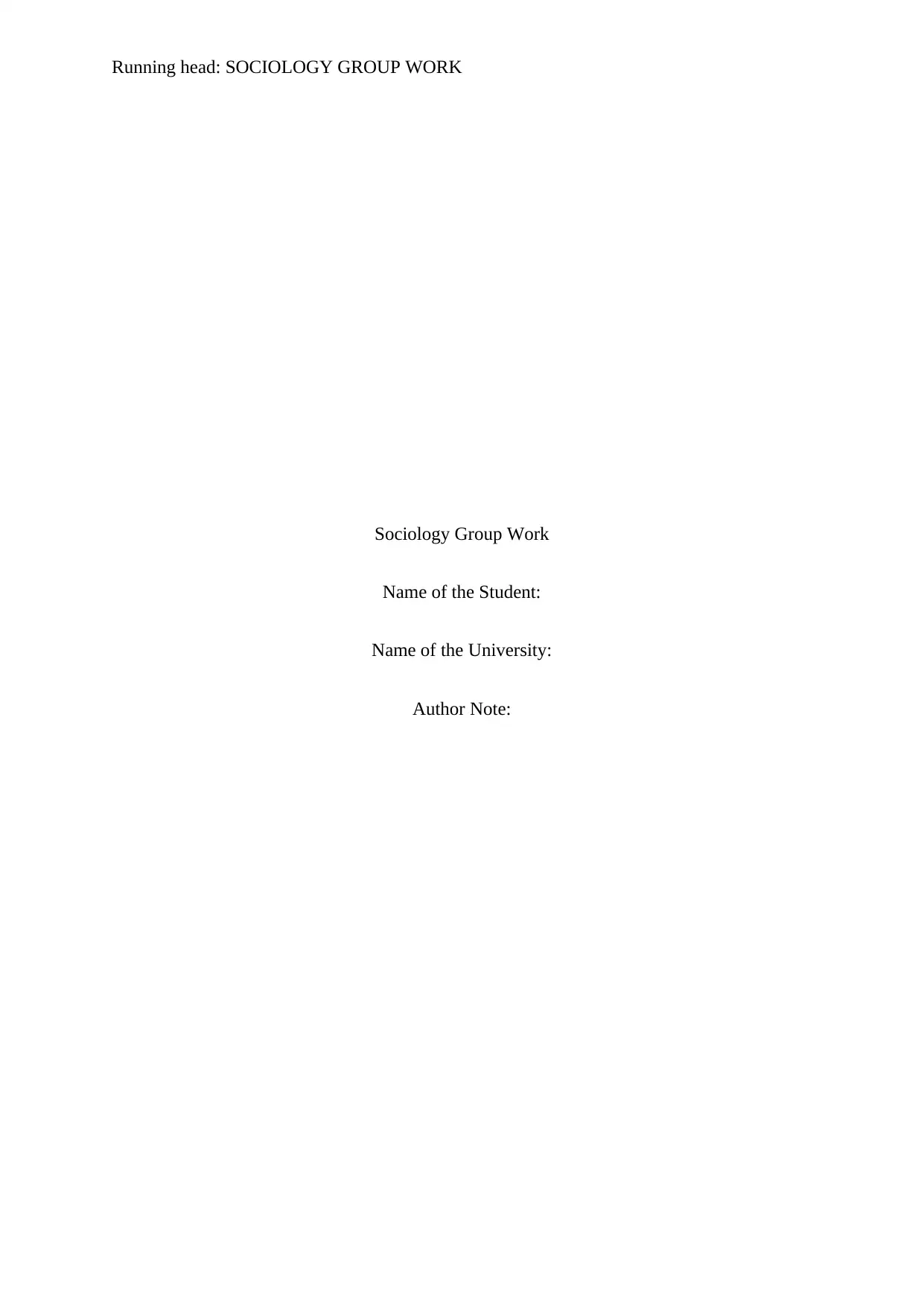
Running head: SOCIOLOGY GROUP WORK
Sociology Group Work
Name of the Student:
Name of the University:
Author Note:
Sociology Group Work
Name of the Student:
Name of the University:
Author Note:
Paraphrase This Document
Need a fresh take? Get an instant paraphrase of this document with our AI Paraphraser
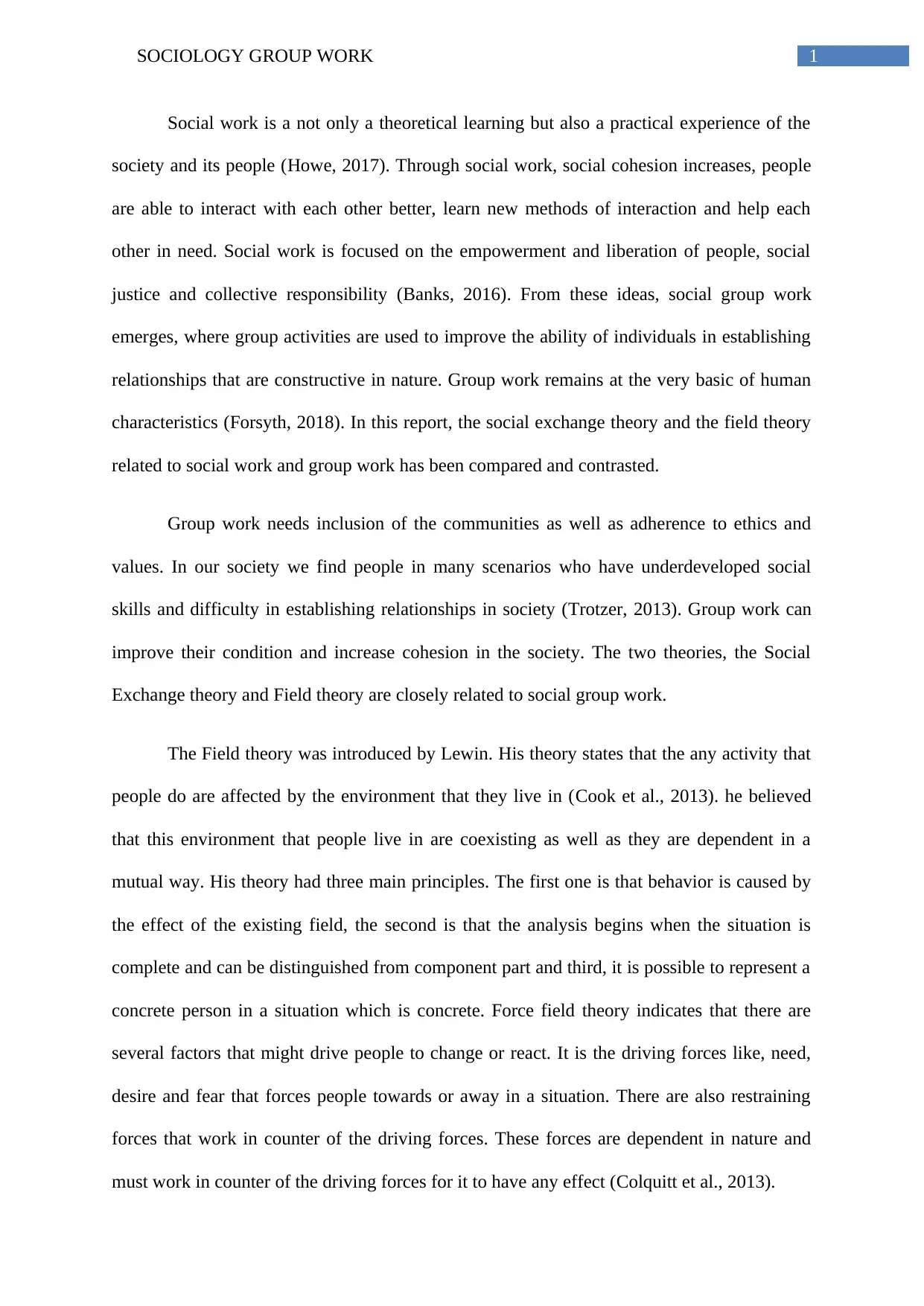
1SOCIOLOGY GROUP WORK
Social work is a not only a theoretical learning but also a practical experience of the
society and its people (Howe, 2017). Through social work, social cohesion increases, people
are able to interact with each other better, learn new methods of interaction and help each
other in need. Social work is focused on the empowerment and liberation of people, social
justice and collective responsibility (Banks, 2016). From these ideas, social group work
emerges, where group activities are used to improve the ability of individuals in establishing
relationships that are constructive in nature. Group work remains at the very basic of human
characteristics (Forsyth, 2018). In this report, the social exchange theory and the field theory
related to social work and group work has been compared and contrasted.
Group work needs inclusion of the communities as well as adherence to ethics and
values. In our society we find people in many scenarios who have underdeveloped social
skills and difficulty in establishing relationships in society (Trotzer, 2013). Group work can
improve their condition and increase cohesion in the society. The two theories, the Social
Exchange theory and Field theory are closely related to social group work.
The Field theory was introduced by Lewin. His theory states that the any activity that
people do are affected by the environment that they live in (Cook et al., 2013). he believed
that this environment that people live in are coexisting as well as they are dependent in a
mutual way. His theory had three main principles. The first one is that behavior is caused by
the effect of the existing field, the second is that the analysis begins when the situation is
complete and can be distinguished from component part and third, it is possible to represent a
concrete person in a situation which is concrete. Force field theory indicates that there are
several factors that might drive people to change or react. It is the driving forces like, need,
desire and fear that forces people towards or away in a situation. There are also restraining
forces that work in counter of the driving forces. These forces are dependent in nature and
must work in counter of the driving forces for it to have any effect (Colquitt et al., 2013).
Social work is a not only a theoretical learning but also a practical experience of the
society and its people (Howe, 2017). Through social work, social cohesion increases, people
are able to interact with each other better, learn new methods of interaction and help each
other in need. Social work is focused on the empowerment and liberation of people, social
justice and collective responsibility (Banks, 2016). From these ideas, social group work
emerges, where group activities are used to improve the ability of individuals in establishing
relationships that are constructive in nature. Group work remains at the very basic of human
characteristics (Forsyth, 2018). In this report, the social exchange theory and the field theory
related to social work and group work has been compared and contrasted.
Group work needs inclusion of the communities as well as adherence to ethics and
values. In our society we find people in many scenarios who have underdeveloped social
skills and difficulty in establishing relationships in society (Trotzer, 2013). Group work can
improve their condition and increase cohesion in the society. The two theories, the Social
Exchange theory and Field theory are closely related to social group work.
The Field theory was introduced by Lewin. His theory states that the any activity that
people do are affected by the environment that they live in (Cook et al., 2013). he believed
that this environment that people live in are coexisting as well as they are dependent in a
mutual way. His theory had three main principles. The first one is that behavior is caused by
the effect of the existing field, the second is that the analysis begins when the situation is
complete and can be distinguished from component part and third, it is possible to represent a
concrete person in a situation which is concrete. Force field theory indicates that there are
several factors that might drive people to change or react. It is the driving forces like, need,
desire and fear that forces people towards or away in a situation. There are also restraining
forces that work in counter of the driving forces. These forces are dependent in nature and
must work in counter of the driving forces for it to have any effect (Colquitt et al., 2013).
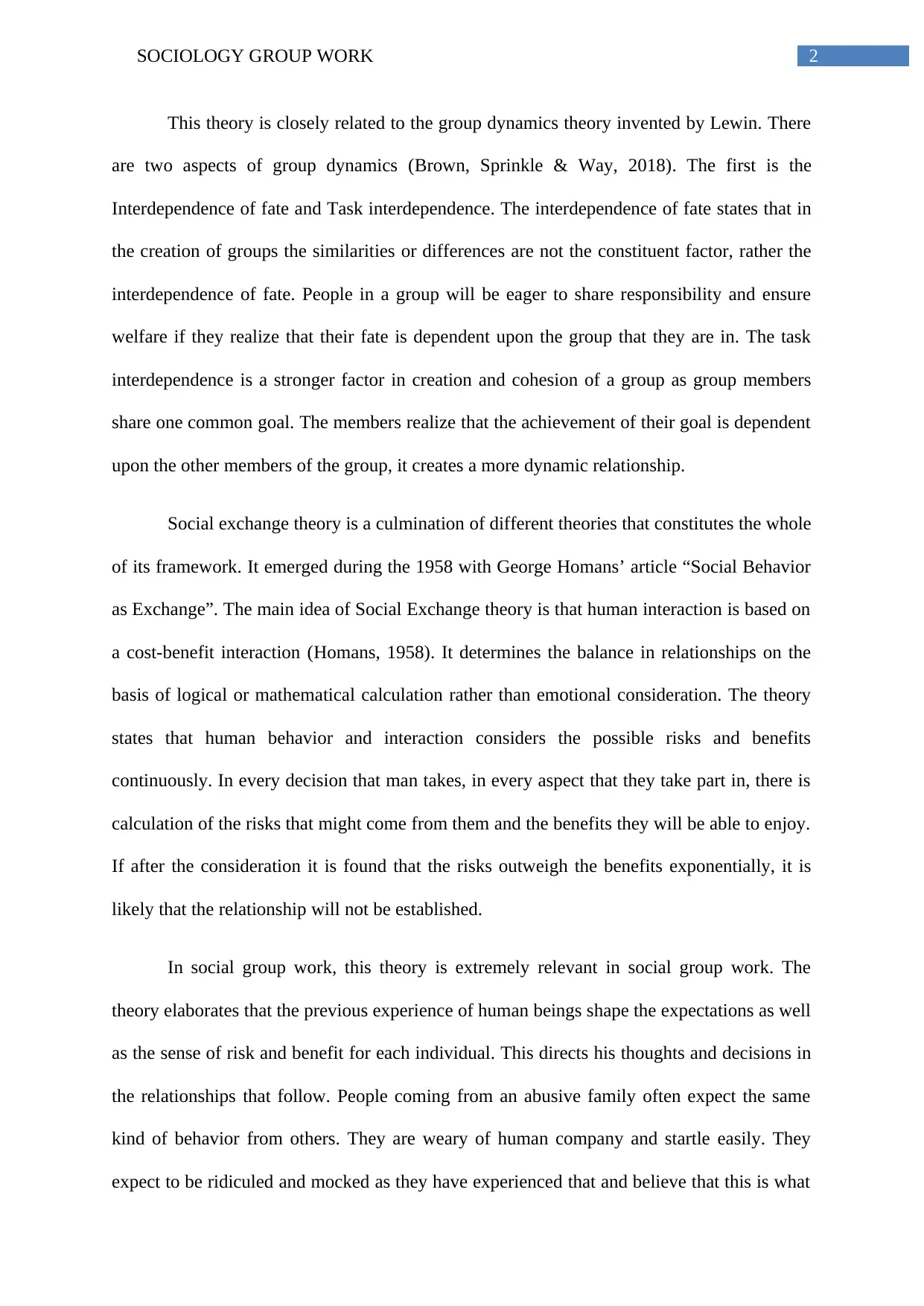
2SOCIOLOGY GROUP WORK
This theory is closely related to the group dynamics theory invented by Lewin. There
are two aspects of group dynamics (Brown, Sprinkle & Way, 2018). The first is the
Interdependence of fate and Task interdependence. The interdependence of fate states that in
the creation of groups the similarities or differences are not the constituent factor, rather the
interdependence of fate. People in a group will be eager to share responsibility and ensure
welfare if they realize that their fate is dependent upon the group that they are in. The task
interdependence is a stronger factor in creation and cohesion of a group as group members
share one common goal. The members realize that the achievement of their goal is dependent
upon the other members of the group, it creates a more dynamic relationship.
Social exchange theory is a culmination of different theories that constitutes the whole
of its framework. It emerged during the 1958 with George Homans’ article “Social Behavior
as Exchange”. The main idea of Social Exchange theory is that human interaction is based on
a cost-benefit interaction (Homans, 1958). It determines the balance in relationships on the
basis of logical or mathematical calculation rather than emotional consideration. The theory
states that human behavior and interaction considers the possible risks and benefits
continuously. In every decision that man takes, in every aspect that they take part in, there is
calculation of the risks that might come from them and the benefits they will be able to enjoy.
If after the consideration it is found that the risks outweigh the benefits exponentially, it is
likely that the relationship will not be established.
In social group work, this theory is extremely relevant in social group work. The
theory elaborates that the previous experience of human beings shape the expectations as well
as the sense of risk and benefit for each individual. This directs his thoughts and decisions in
the relationships that follow. People coming from an abusive family often expect the same
kind of behavior from others. They are weary of human company and startle easily. They
expect to be ridiculed and mocked as they have experienced that and believe that this is what
This theory is closely related to the group dynamics theory invented by Lewin. There
are two aspects of group dynamics (Brown, Sprinkle & Way, 2018). The first is the
Interdependence of fate and Task interdependence. The interdependence of fate states that in
the creation of groups the similarities or differences are not the constituent factor, rather the
interdependence of fate. People in a group will be eager to share responsibility and ensure
welfare if they realize that their fate is dependent upon the group that they are in. The task
interdependence is a stronger factor in creation and cohesion of a group as group members
share one common goal. The members realize that the achievement of their goal is dependent
upon the other members of the group, it creates a more dynamic relationship.
Social exchange theory is a culmination of different theories that constitutes the whole
of its framework. It emerged during the 1958 with George Homans’ article “Social Behavior
as Exchange”. The main idea of Social Exchange theory is that human interaction is based on
a cost-benefit interaction (Homans, 1958). It determines the balance in relationships on the
basis of logical or mathematical calculation rather than emotional consideration. The theory
states that human behavior and interaction considers the possible risks and benefits
continuously. In every decision that man takes, in every aspect that they take part in, there is
calculation of the risks that might come from them and the benefits they will be able to enjoy.
If after the consideration it is found that the risks outweigh the benefits exponentially, it is
likely that the relationship will not be established.
In social group work, this theory is extremely relevant in social group work. The
theory elaborates that the previous experience of human beings shape the expectations as well
as the sense of risk and benefit for each individual. This directs his thoughts and decisions in
the relationships that follow. People coming from an abusive family often expect the same
kind of behavior from others. They are weary of human company and startle easily. They
expect to be ridiculed and mocked as they have experienced that and believe that this is what
⊘ This is a preview!⊘
Do you want full access?
Subscribe today to unlock all pages.

Trusted by 1+ million students worldwide
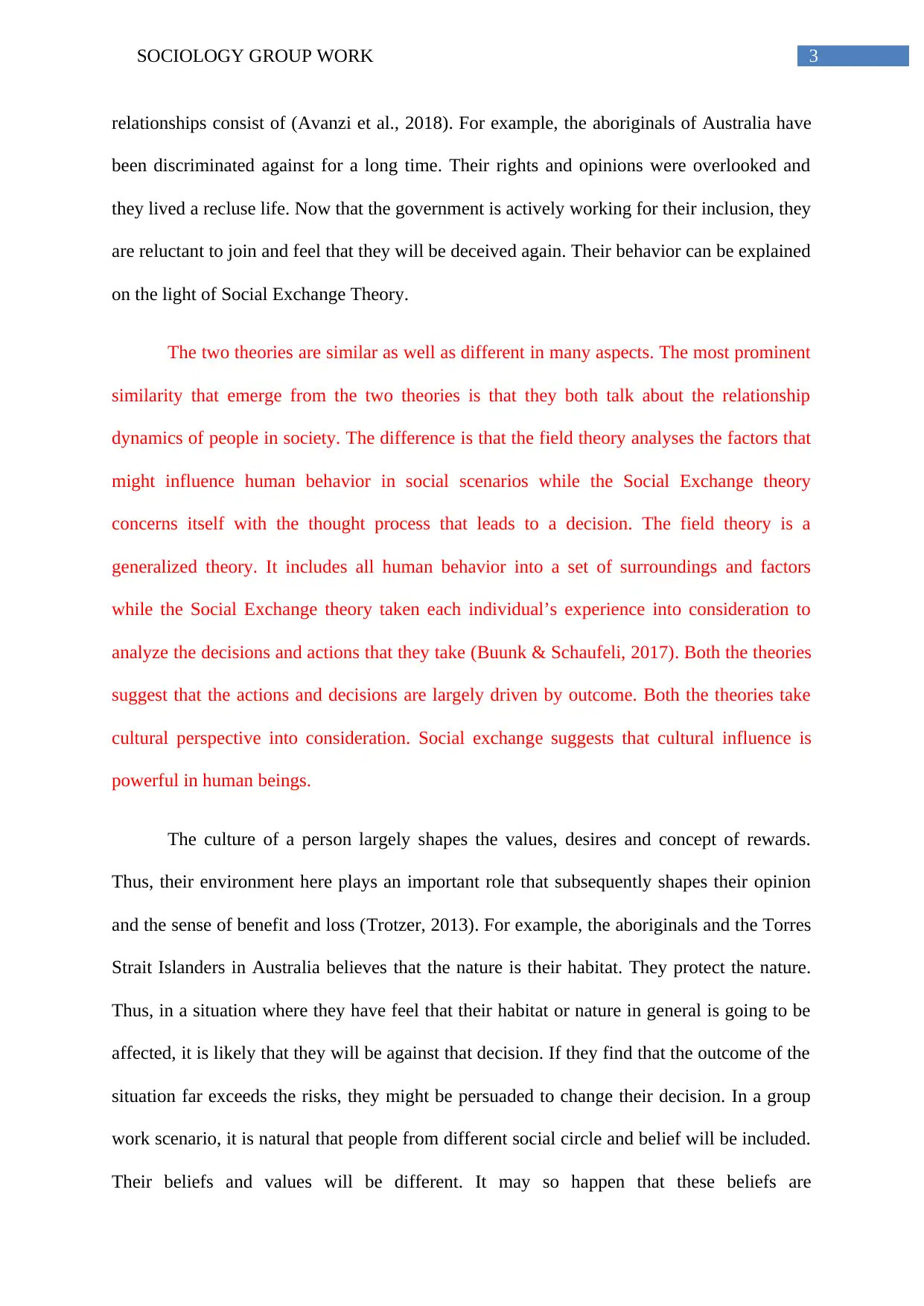
3SOCIOLOGY GROUP WORK
relationships consist of (Avanzi et al., 2018). For example, the aboriginals of Australia have
been discriminated against for a long time. Their rights and opinions were overlooked and
they lived a recluse life. Now that the government is actively working for their inclusion, they
are reluctant to join and feel that they will be deceived again. Their behavior can be explained
on the light of Social Exchange Theory.
The two theories are similar as well as different in many aspects. The most prominent
similarity that emerge from the two theories is that they both talk about the relationship
dynamics of people in society. The difference is that the field theory analyses the factors that
might influence human behavior in social scenarios while the Social Exchange theory
concerns itself with the thought process that leads to a decision. The field theory is a
generalized theory. It includes all human behavior into a set of surroundings and factors
while the Social Exchange theory taken each individual’s experience into consideration to
analyze the decisions and actions that they take (Buunk & Schaufeli, 2017). Both the theories
suggest that the actions and decisions are largely driven by outcome. Both the theories take
cultural perspective into consideration. Social exchange suggests that cultural influence is
powerful in human beings.
The culture of a person largely shapes the values, desires and concept of rewards.
Thus, their environment here plays an important role that subsequently shapes their opinion
and the sense of benefit and loss (Trotzer, 2013). For example, the aboriginals and the Torres
Strait Islanders in Australia believes that the nature is their habitat. They protect the nature.
Thus, in a situation where they have feel that their habitat or nature in general is going to be
affected, it is likely that they will be against that decision. If they find that the outcome of the
situation far exceeds the risks, they might be persuaded to change their decision. In a group
work scenario, it is natural that people from different social circle and belief will be included.
Their beliefs and values will be different. It may so happen that these beliefs are
relationships consist of (Avanzi et al., 2018). For example, the aboriginals of Australia have
been discriminated against for a long time. Their rights and opinions were overlooked and
they lived a recluse life. Now that the government is actively working for their inclusion, they
are reluctant to join and feel that they will be deceived again. Their behavior can be explained
on the light of Social Exchange Theory.
The two theories are similar as well as different in many aspects. The most prominent
similarity that emerge from the two theories is that they both talk about the relationship
dynamics of people in society. The difference is that the field theory analyses the factors that
might influence human behavior in social scenarios while the Social Exchange theory
concerns itself with the thought process that leads to a decision. The field theory is a
generalized theory. It includes all human behavior into a set of surroundings and factors
while the Social Exchange theory taken each individual’s experience into consideration to
analyze the decisions and actions that they take (Buunk & Schaufeli, 2017). Both the theories
suggest that the actions and decisions are largely driven by outcome. Both the theories take
cultural perspective into consideration. Social exchange suggests that cultural influence is
powerful in human beings.
The culture of a person largely shapes the values, desires and concept of rewards.
Thus, their environment here plays an important role that subsequently shapes their opinion
and the sense of benefit and loss (Trotzer, 2013). For example, the aboriginals and the Torres
Strait Islanders in Australia believes that the nature is their habitat. They protect the nature.
Thus, in a situation where they have feel that their habitat or nature in general is going to be
affected, it is likely that they will be against that decision. If they find that the outcome of the
situation far exceeds the risks, they might be persuaded to change their decision. In a group
work scenario, it is natural that people from different social circle and belief will be included.
Their beliefs and values will be different. It may so happen that these beliefs are
Paraphrase This Document
Need a fresh take? Get an instant paraphrase of this document with our AI Paraphraser
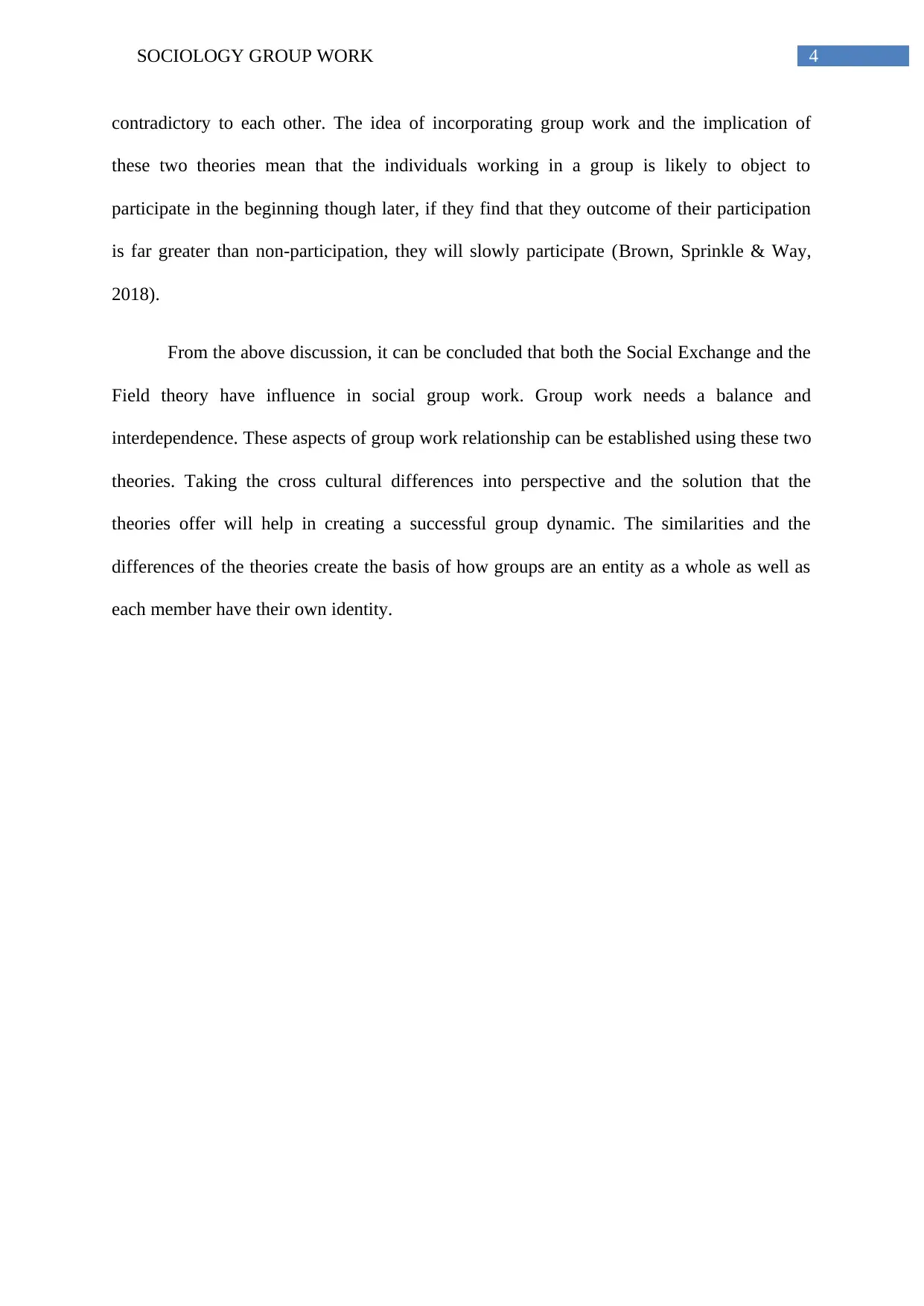
4SOCIOLOGY GROUP WORK
contradictory to each other. The idea of incorporating group work and the implication of
these two theories mean that the individuals working in a group is likely to object to
participate in the beginning though later, if they find that they outcome of their participation
is far greater than non-participation, they will slowly participate (Brown, Sprinkle & Way,
2018).
From the above discussion, it can be concluded that both the Social Exchange and the
Field theory have influence in social group work. Group work needs a balance and
interdependence. These aspects of group work relationship can be established using these two
theories. Taking the cross cultural differences into perspective and the solution that the
theories offer will help in creating a successful group dynamic. The similarities and the
differences of the theories create the basis of how groups are an entity as a whole as well as
each member have their own identity.
contradictory to each other. The idea of incorporating group work and the implication of
these two theories mean that the individuals working in a group is likely to object to
participate in the beginning though later, if they find that they outcome of their participation
is far greater than non-participation, they will slowly participate (Brown, Sprinkle & Way,
2018).
From the above discussion, it can be concluded that both the Social Exchange and the
Field theory have influence in social group work. Group work needs a balance and
interdependence. These aspects of group work relationship can be established using these two
theories. Taking the cross cultural differences into perspective and the solution that the
theories offer will help in creating a successful group dynamic. The similarities and the
differences of the theories create the basis of how groups are an entity as a whole as well as
each member have their own identity.
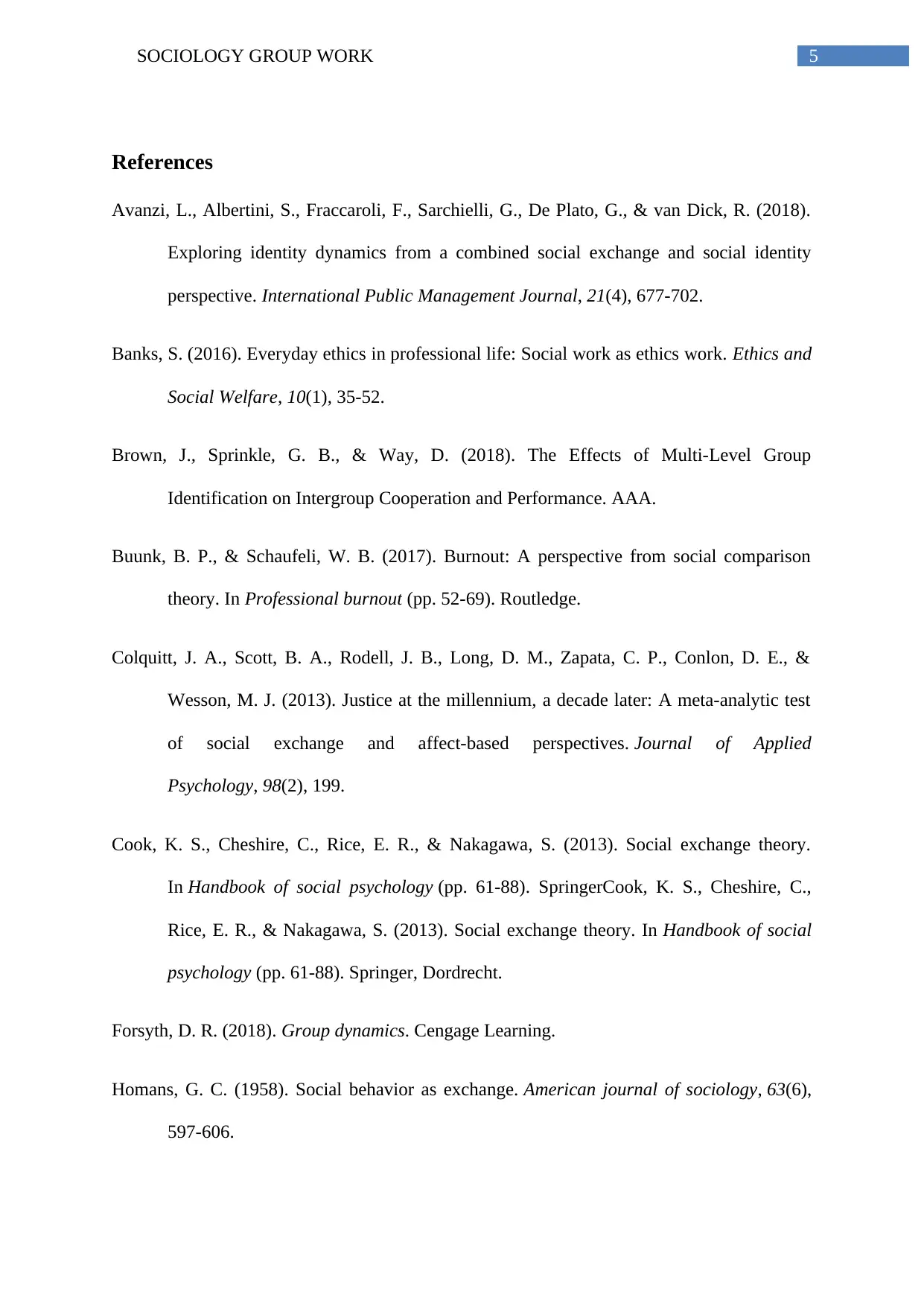
5SOCIOLOGY GROUP WORK
References
Avanzi, L., Albertini, S., Fraccaroli, F., Sarchielli, G., De Plato, G., & van Dick, R. (2018).
Exploring identity dynamics from a combined social exchange and social identity
perspective. International Public Management Journal, 21(4), 677-702.
Banks, S. (2016). Everyday ethics in professional life: Social work as ethics work. Ethics and
Social Welfare, 10(1), 35-52.
Brown, J., Sprinkle, G. B., & Way, D. (2018). The Effects of Multi-Level Group
Identification on Intergroup Cooperation and Performance. AAA.
Buunk, B. P., & Schaufeli, W. B. (2017). Burnout: A perspective from social comparison
theory. In Professional burnout (pp. 52-69). Routledge.
Colquitt, J. A., Scott, B. A., Rodell, J. B., Long, D. M., Zapata, C. P., Conlon, D. E., &
Wesson, M. J. (2013). Justice at the millennium, a decade later: A meta-analytic test
of social exchange and affect-based perspectives. Journal of Applied
Psychology, 98(2), 199.
Cook, K. S., Cheshire, C., Rice, E. R., & Nakagawa, S. (2013). Social exchange theory.
In Handbook of social psychology (pp. 61-88). SpringerCook, K. S., Cheshire, C.,
Rice, E. R., & Nakagawa, S. (2013). Social exchange theory. In Handbook of social
psychology (pp. 61-88). Springer, Dordrecht.
Forsyth, D. R. (2018). Group dynamics. Cengage Learning.
Homans, G. C. (1958). Social behavior as exchange. American journal of sociology, 63(6),
597-606.
References
Avanzi, L., Albertini, S., Fraccaroli, F., Sarchielli, G., De Plato, G., & van Dick, R. (2018).
Exploring identity dynamics from a combined social exchange and social identity
perspective. International Public Management Journal, 21(4), 677-702.
Banks, S. (2016). Everyday ethics in professional life: Social work as ethics work. Ethics and
Social Welfare, 10(1), 35-52.
Brown, J., Sprinkle, G. B., & Way, D. (2018). The Effects of Multi-Level Group
Identification on Intergroup Cooperation and Performance. AAA.
Buunk, B. P., & Schaufeli, W. B. (2017). Burnout: A perspective from social comparison
theory. In Professional burnout (pp. 52-69). Routledge.
Colquitt, J. A., Scott, B. A., Rodell, J. B., Long, D. M., Zapata, C. P., Conlon, D. E., &
Wesson, M. J. (2013). Justice at the millennium, a decade later: A meta-analytic test
of social exchange and affect-based perspectives. Journal of Applied
Psychology, 98(2), 199.
Cook, K. S., Cheshire, C., Rice, E. R., & Nakagawa, S. (2013). Social exchange theory.
In Handbook of social psychology (pp. 61-88). SpringerCook, K. S., Cheshire, C.,
Rice, E. R., & Nakagawa, S. (2013). Social exchange theory. In Handbook of social
psychology (pp. 61-88). Springer, Dordrecht.
Forsyth, D. R. (2018). Group dynamics. Cengage Learning.
Homans, G. C. (1958). Social behavior as exchange. American journal of sociology, 63(6),
597-606.
⊘ This is a preview!⊘
Do you want full access?
Subscribe today to unlock all pages.

Trusted by 1+ million students worldwide

6SOCIOLOGY GROUP WORK
Howe, D. (2017). An introduction to social work theory. Routledge.
Trotzer, J. P. (2013). Counselor and The Group: Integrating Theory, Training, and Practice.
Taylor & Francis.
Howe, D. (2017). An introduction to social work theory. Routledge.
Trotzer, J. P. (2013). Counselor and The Group: Integrating Theory, Training, and Practice.
Taylor & Francis.
1 out of 7
Related Documents
Your All-in-One AI-Powered Toolkit for Academic Success.
+13062052269
info@desklib.com
Available 24*7 on WhatsApp / Email
![[object Object]](/_next/static/media/star-bottom.7253800d.svg)
Unlock your academic potential
Copyright © 2020–2025 A2Z Services. All Rights Reserved. Developed and managed by ZUCOL.




